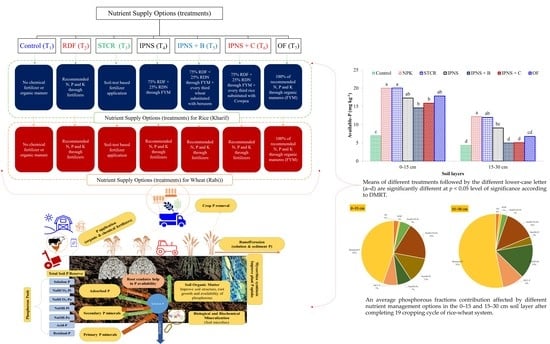Long-Term Nutrient Supply Options: Strategies to Improve Soil Phosphorus Availability in the Rice-Wheat System
Abstract
:1. Introduction
2. Materials and Methods
2.1. Site Descriptions
2.2. Treatments and Experimental Design
2.3. Collection, Processing, and Analysis of Soil Samples
2.4. Modified Hedley Fractionation Method of Phosphorus
2.5. Statistical Analysis
3. Result and Discussion
3.1. Effect of Long-Term Nutrients Supply Options on Soil Available Phosphorus
3.2. Effect of Long-Term Nutrients Supply Options on Water Soluble Phosphorous (WSP)
3.3. Effect of Long-Term Nutrients Supply Options on NaHCO3-Pi
3.4. Effect of Long-Term Nutrients Supply Options on NaHCO3-Po
3.5. Effect of Long-Term Nutrients Supply Options on NaOH-Pi
3.6. Effect of Long-Term Nutrients Supply Options on NaOH-Po
3.7. Effect of Long-Term Nutrients Supply Options on HCl-P
3.8. Effect of Long-Term Nutrients Supply Options on Residual Phosphorous
3.9. Effect of Long-Term Nutrients Supply Options on Soil Phosphorus Fractions Contribution
3.10. Relationship between P-Fractions
4. Conclusions and Recommendations
Author Contributions
Funding
Institutional Review Board Statement
Informed Consent Statement
Data Availability Statement
Acknowledgments
Conflicts of Interest
References
- European Commission. Study on the EU’s List of Critical Raw Materials (Final Report); European Commission: Brussels, Belgium, 2020.
- UNEP. Emerging Issues in Our Global Environment. UNEP Year Book-2011; United Nations Environment Programme: Nairobi, Kenya, 2011; Available online: http://www.unep.org/yearbook/2011 (accessed on 30 January 2022).
- FAO Statistical Yearbook. Africa Food and Agriculture, Part-2: Hunger Dimension; Food and Agricultural Organizations of the United Nations: Rome, Italy, 2014; Available online: http://www.fao.org/3/a-i3620e.pdf (accessed on 5 February 2022).
- Chowdhury, R.B.; Zhang, X. Phosphorus use efficiency in agricultural systems: A comprehensive assessment through the review of national scale substance flow analyses. Ecol. Indic. 2021, 121, 107172. [Google Scholar] [CrossRef]
- Chowdhury, R.B.; Chakraborty, P. Magnitude of anthropogenic phosphorus storage in the agricultural production and the waste management systems in the regional and country scales. Environ. Sci. Pollut. Res. 2016, 23, 15929–15940. [Google Scholar] [CrossRef] [PubMed]
- Chowdhury, R.B.; Moore, G.A.; Weatherley, A.J.; Arora, M. A novel substance flow analysis model for analysing multi-year phosphorus flow at the regional scale. Sci. Total Environ. 2016, 572, 1269–1280. [Google Scholar] [CrossRef] [PubMed]
- Chowdhury, R.B.; Moore, G.A.; Weatherley, A.J. A multi-year phosphorus flow analysis of a key agricultural region in Australia to identify options for sustainable management. Agric. Syst. 2018, 161, 42–60. [Google Scholar] [CrossRef]
- Chowdhury, R.B.; Moore, G.A.; Weatherley, A.J.; Arora, M. A review of recent substance flow analyses of phosphorus to identify priority management areas at different geographical scales. Resour. Conserv. Recycl. 2014, 83, 213–228. [Google Scholar] [CrossRef]
- UNDP. Sustainable Development Goals (SDGs); United Nations Development Programme: New York, NY, USA, 2016; Available online: http://www.undp.org/content/undp/en/home/sdgoverview/post-2015-development-agenda.html (accessed on 30 January 2022).
- Woolston, C. Healthy people, healthy planet. Nature 2020, 588, S54–S56. [Google Scholar] [CrossRef]
- Eisenstein, M. Natural solutions for agricultural productivity. Nature 2020, 588, S58–S59. [Google Scholar] [CrossRef]
- Puggaard, L.; Lund, P.; Liesegang, A.; Sehested, J. Long term effect of reduced dietary phosphorus on feed intake and milk yield in dry and lactating dairy cows. Livest. Sci. 2014, 159, 18–28. [Google Scholar] [CrossRef]
- Bindraban, P.S.; Dimkpa, C.O.; Pandey, R. Exploring phosphorus fertilizers and fertilization strategies for improved human and environmental health. Biol. Fertil. Soils 2020, 56, 299–317. [Google Scholar] [CrossRef] [Green Version]
- Leinweber, P.; Bathmann, U.; Buczko, U.; Douhaire, C.; Eichler-Löbermann, B.; Frossard, E.; Ekardt, F.; Jarvie, H.; Krämer, I.; Kabbe, C.; et al. Handling the phosphorus paradox in agriculture and natural ecosystems: Scarcity, necessity, and burden of P. Ambio 2018, 47, 3–19. [Google Scholar] [CrossRef] [Green Version]
- Liu, G.; Deng, L.; Wu, R.; Guo, S.; Du, W.; Yang, M.; Bian, J.; Liu, Y.; Li, B.; Chen, F. Determination of nitrogen and phosphorus fertilisation rates for tobacco based on economic response and nutrient concentrations in local stream water. Agric. Ecosyst. Environ. 2020, 304, 107136. [Google Scholar] [CrossRef]
- Suh, S.; Yee, S. Phosphorus use-efficiency of agriculture and food system in the US. Chemosphere 2011, 84, 806–813. [Google Scholar] [CrossRef] [PubMed]
- Sutton, M.A.; Bleeker, A.; Howard, C.M.; Bekunda, M.; Grizzetti, B.; de Vries, W.; van Grinsven, H.J.M.; Abrol, Y.P.; Adhya, T.K.; Billen, G.; et al. Our Nutrient World: The Challenge to Produce More Food and Energy with Less Pollution; Centre for Ecology and Hydrology (CEH): Edinburgh, UK; United Nations Environment Program (UNEP): Nairobi, Kenya, 2013. [Google Scholar]
- FAO. Current World Fertilizer Trends and Outlook to 2015; Food and Agriculture Organisation of the United Nations: Rome, Italy, 2011; Available online: http://ftp.fao.org/ag/agp/docs/cwfto15.pdf (accessed on 5 February 2022).
- Minemakers Limited. Rock Phosphate Price Rockets to Us$200/Tonne. Feasibility Planning Initiated on the Wonarah Project, Northern Territory. ASX and Press Release, 9 January 2008; Minemakers Limited (ABN 48116296541): West Perth, Australia, 2008; Available online: http://www.minemakers.com.au/downloads/News/080109RockPhosphatePriceSkyRockets.pdf (accessed on 5 February 2022).
- ACCC (Australian Competition and Consumer Commission). ACCC Examination of Fertiliser Prices; Australian Competition and Consumer Commission: Canberra, Australia, 2008. Available online: http://www.accc.gov.au/publications/accc-examination-of-fertiliser-prices (accessed on 30 January 2022).
- Liu, E.; Yan, C.; Mei, X.; He, W.; Bing, S.H.; Ding, L.; Liu, Q.; Liu, S.; Fan, T. Long-term effect of chemical fertilizer, straw, and manure on soil chemical and biological properties in northwest China. Geoderma 2010, 158, 173–180. [Google Scholar] [CrossRef]
- The Guardian. Soaring Fertiliser Prices Threaten World’s Poorest Farmers; The Guardian: London, UK, 2008; Available online: http://www.theguardian.com/environment/2008/aug/12/biofuels.food (accessed on 30 January 2022).
- Bononi, L.; Chiaramonte, J.B.; Pansa, C.C.; Moitinho, M.A.; Melo, I.S. Phosphorus-solubilizing Trichoderma spp. from Amazon soils improve soybean plant growth. Sci. Rep. 2020, 10, 2858. [Google Scholar]
- Castagno, L.N.; Sannazzaro, A.I.; Gonzalez, M.E.; Pieckenstain, F.L.; Estrella, M.J. Phosphobacteria as key actors to overcome phosphorus deficiency in plants. Ann. Appl. Biol. 2021, 178, 256–267. [Google Scholar] [CrossRef]
- Ch’ng, H.Y.; Ahmed, O.H.; Majid, N.M.A. Improving phosphorus availability in an acid soil using organic amendments produced from agroindustrial wastes. Sci. World J. 2014, 2014, 506356. [Google Scholar] [CrossRef]
- Duboc, O.; Hernandez-Mora, A.; Wenzel, W.W.; Santner, J. Improving the prediction of fertilizer phosphorus availability to plants with simple, but non-standardized extraction techniques. Sci. Total Environ. 2021, 806, 150486. [Google Scholar] [CrossRef]
- Nandan, R.; Poonia, S.P.; Singh, S.S.; Nath, C.P.; Kumar, V.; Malik, R.K.; McDonald, A.; Hazra, K.K. Potential of conservation agriculture modules for energy conservation and sustainability of rice-based production systems of Indo-Gangetic Plain region. Environ. Sci. Pollut. Res. 2021, 28, 246–261. [Google Scholar] [CrossRef]
- Bhatt, R.; Kukal, S.S.; Busari, M.A.; Arora, S.; Yadav, M. Sustainability issues on rice-wheat cropping system. Int. Soil Water Conserv. Res. 2016, 4, 64–67. [Google Scholar] [CrossRef] [Green Version]
- Montpellier Panel Report. Sustainable Intensification: A New Paradigm for Africa Agriculture. Agriculture for Impact, 15 Princes Gardens; South Kensington Campus, Imperial College: London, UK, 2013; Available online: https://ag4impact.org/wp-content/uploads/2013/04/MP_0176_Report_Redesign_2016.pdf (accessed on 29 July 2019).
- Muller, A.; Schader, C.; El-Hage Scialabba, N.; Brüggemann, J.; Isensee, A.; Erb, K.-H.; Smith, P.; Klocke, P.; Leiber, F.; Stolze, M.; et al. Strategies for feeding the world more sustainably with organic agriculture. Nat. Commun. 2017, 8, 1290. [Google Scholar] [CrossRef] [Green Version]
- Zhao, Y.; Li, Y.; Yang, F. Critical review on soil phosphorus migration and transformation under freezing-thawing cycles and typical regulatory measurements. Sci. Total Environ. 2021, 751, 141614. [Google Scholar] [CrossRef] [PubMed]
- Levy, E.T.; Schlesinger, W.H. A comparison of fractionation methods for forms of phosphorus in soils. Biogeochemistry 1999, 47, 25–38. [Google Scholar] [CrossRef]
- Gomez, K.A.; Gomez, A.A. Statistical Procedures for Agricultural Research; John Wiley and Sons: New York, NY, USA, 1984; 680p. [Google Scholar]
- Alori, E.T.; Glick, B.R.; Babalola, O.O. Microbial phosphorus solubilization and its potential for use in sustainable agriculture. Front. Microbiol. 2017, 8, 971. [Google Scholar] [CrossRef] [PubMed] [Green Version]
- FAO. Pulses and Climate Change; Food and Agriculture Organization of the United Nations: Rome, Italy, 2016; Available online: http://www.fao.org/fileadmin/user_upload/pulses-2016/docs/factsheets/Climate_EN_PRINT.pdf (accessed on 30 January 2022).
- Ohno, T.; Hoskins, B.R.; Erich, M.S. Soil organic matter effects on plant available and water-soluble phosphorus. Biol. Fert. Soils 2007, 43, 683–690. [Google Scholar] [CrossRef]
- Bhattacharyya, P.N.; Jha, D.K. Plant growth-promoting rhizobacteria (PGPR): Emergence in agriculture. World J. Microbiol. Biotechnol. 2012, 28, 1327–1350. [Google Scholar] [CrossRef]
- Meena, M.D.; Biswas, D.R. Phosphorus and potassium transformations in soil amended with enriched compost and chemical fertilizers in a wheat–soybean cropping system. Commun. Soil Sci. Plant Anal. 2014, 45, 624–652. [Google Scholar] [CrossRef]
- Reddy, D.; Kushwah, S.; Srivastava, S.; Khamparia, R.S. Long-term wheat residue management and supplementary nutrient input effects on phosphorus fractions and adsorption behavior in a Vertisol. Commun. Soil Sci. Plant Anal. 2014, 45, 541–554. [Google Scholar] [CrossRef]
- Haokip, I.C.; Dwivedi, B.S.; Meena, M.C.; Datta, S.P.; Jat, H.S.; Dey, A.; Tigga, P. Effect of conservation agriculture and nutrient management options on soil phosphorus fractions under maize-wheat cropping system. J. Indian Soc. Soil Sci. 2020, 68, 45–53. [Google Scholar] [CrossRef]
- Cross, A.F.; Schlesinger, W.H. A literature review and evaluation of the. Hedley fractionation: Applications to the biogeochemical cycle of soil phosphorus in natural ecosystems. Geoderma 1995, 64, 197–214. [Google Scholar] [CrossRef]
- De Schrijver, A.; Vesterdal, L.; Hansen, K.; De Frenne, P.; Augusto, L.; Achat, D.L.; Staelens, J.; Baeten, L.; De Keersmaeker, L.; De Neve, S.; et al. Four decades of post-agricultural forest development have caused major redistributions of soil phosphorus fractions. Oecologia 2012, 169, 221–234. [Google Scholar] [CrossRef]
- Sattari, S.Z.; Ittersum, M.K.V.; Giller, K.E.; Zhang, F.; Bouwman, A.F. Key role of China and its agriculture in global sustainable phosphorus management. Environ. Res. Lett. 2014, 9, 054003. [Google Scholar] [CrossRef] [Green Version]
- Henríquez, C.; Killorn, R. Soil P forms and P uptake under intensive plant growth in the greenhouse. Agron. Costarric. 2005, 29, 83–97. [Google Scholar]
- Urkurkar, J.S.; Tiwari, A.; Chitale, S.; Bajpai, R.K. Influence of long-term use of inorganic and organic manures on soil fertility and sustainable productivity of rice (Oryza sativa) and wheat (Triticum aestivum) in Inceptisols. Indian J. Agric. Sci. 2010, 80, 208–212. [Google Scholar]
- Subehia, S.K.; Sepehya, S.; Rana, S.S.; Negi, S.C.; Sharma, S.K. Long-term effect of organic and inorganic fertilizers on rice (Oryza sativa L.)-wheat (Triticum aestivum L.) yield, and chemical properties of an acidic soil in the western Himalayas. Expl. Agric. 2013, 49, 382–394. [Google Scholar] [CrossRef]
- Chowdhury, R.B.; Moore, G.A.; Weatherley, A.J.; Arora, M. Key sustainability challenges for the global phosphorus resource, their implications for global food security, and options for mitigation. J. Clean. Prod. 2017, 140, 945–963. [Google Scholar] [CrossRef]
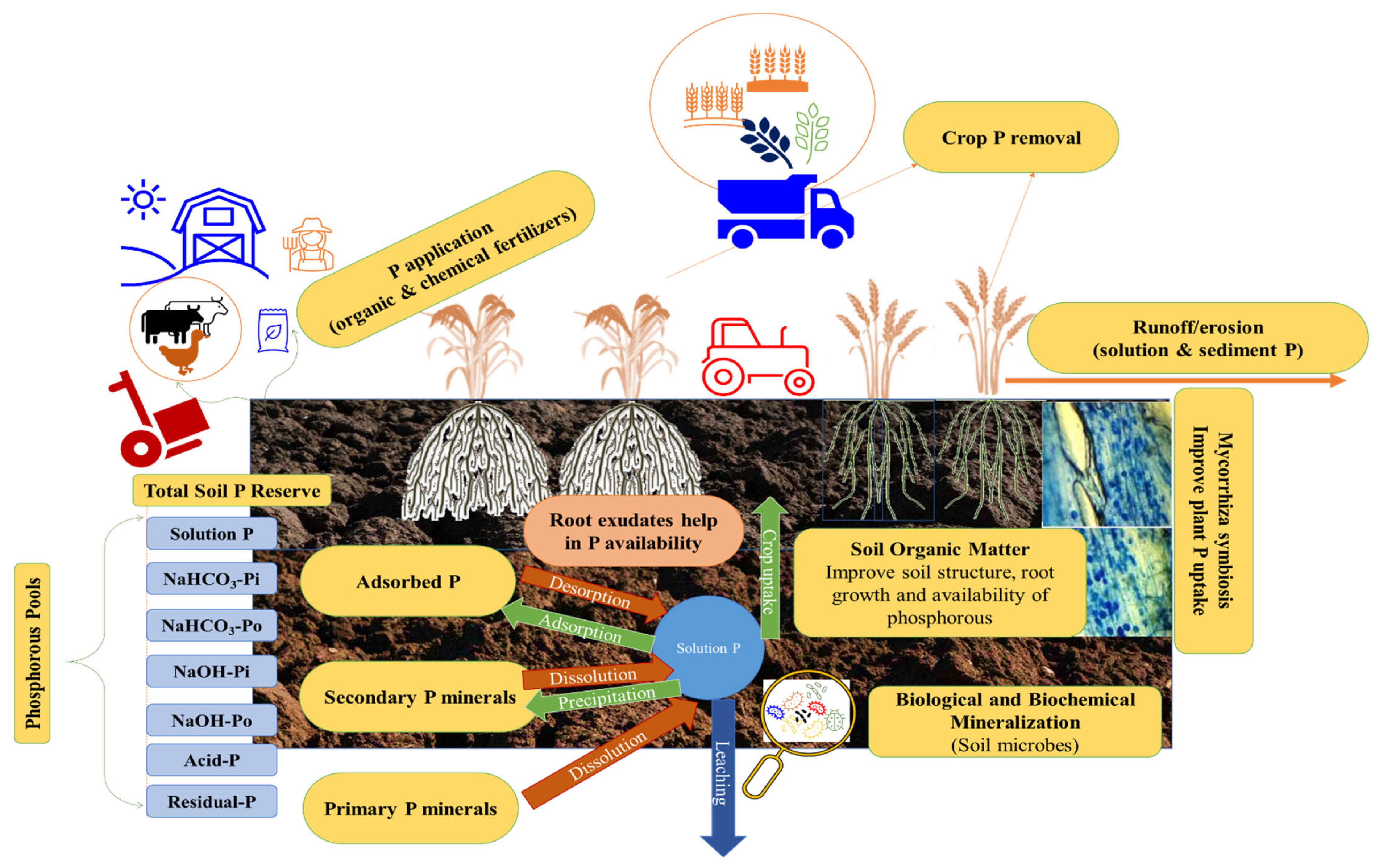
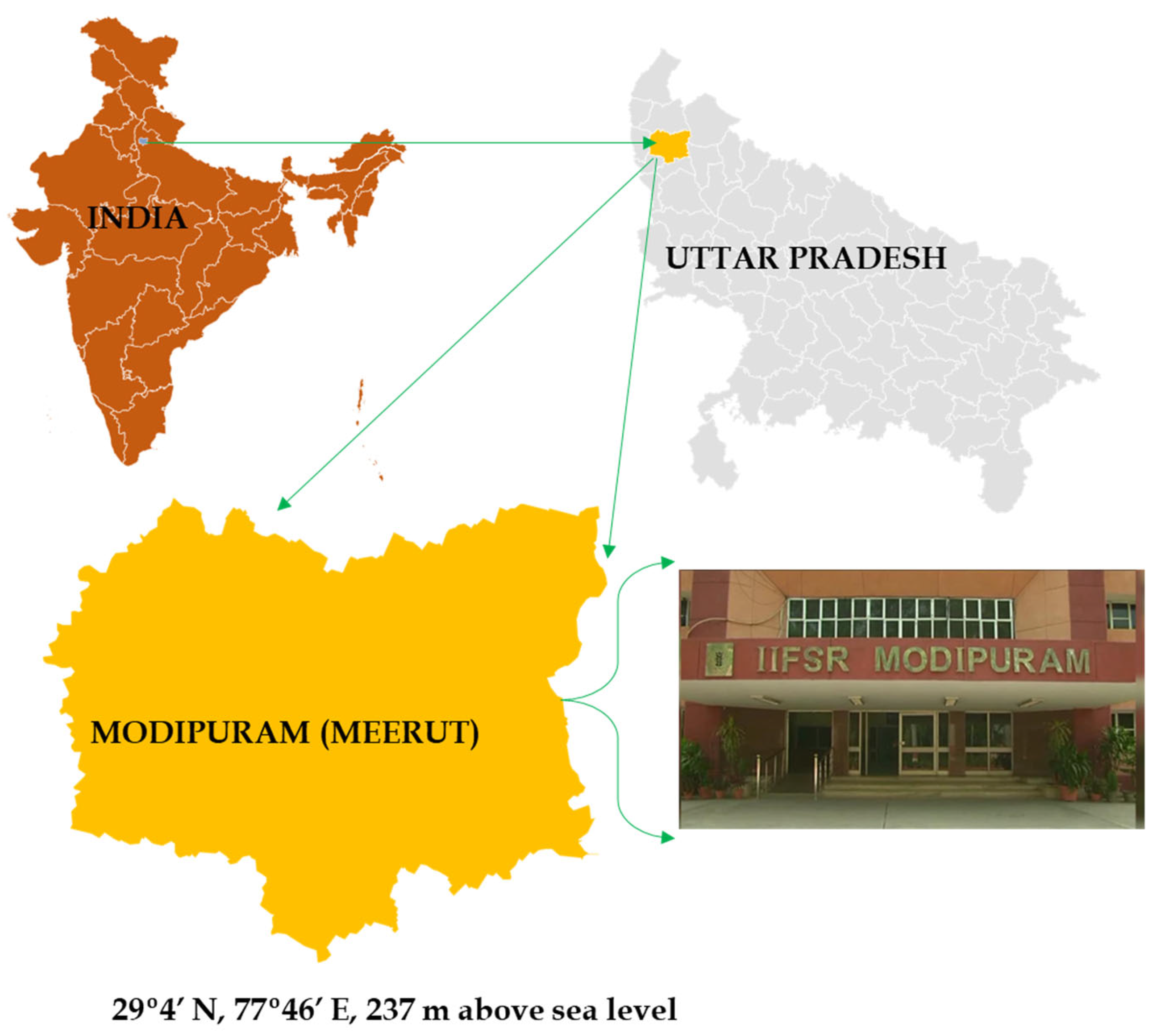
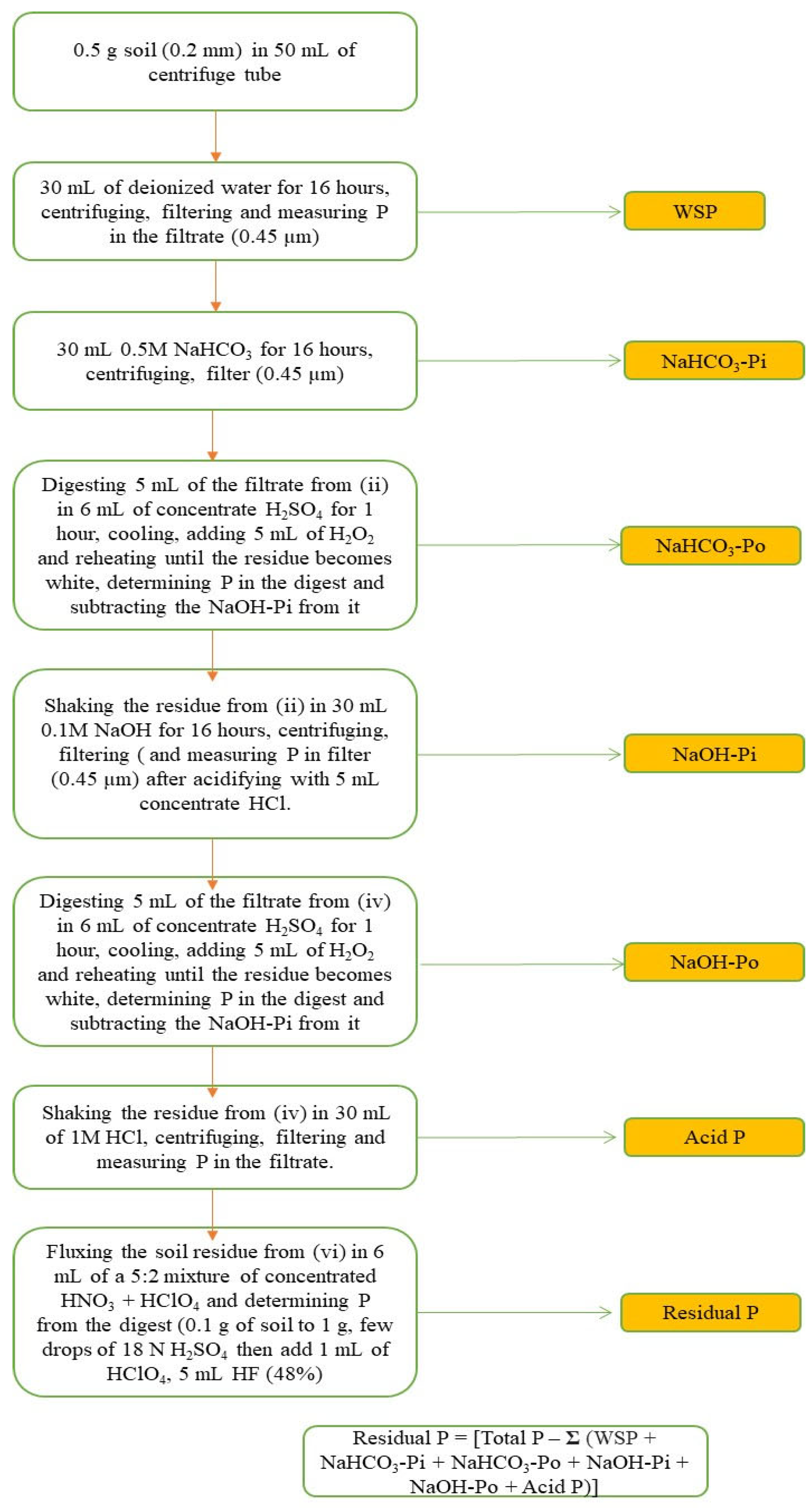
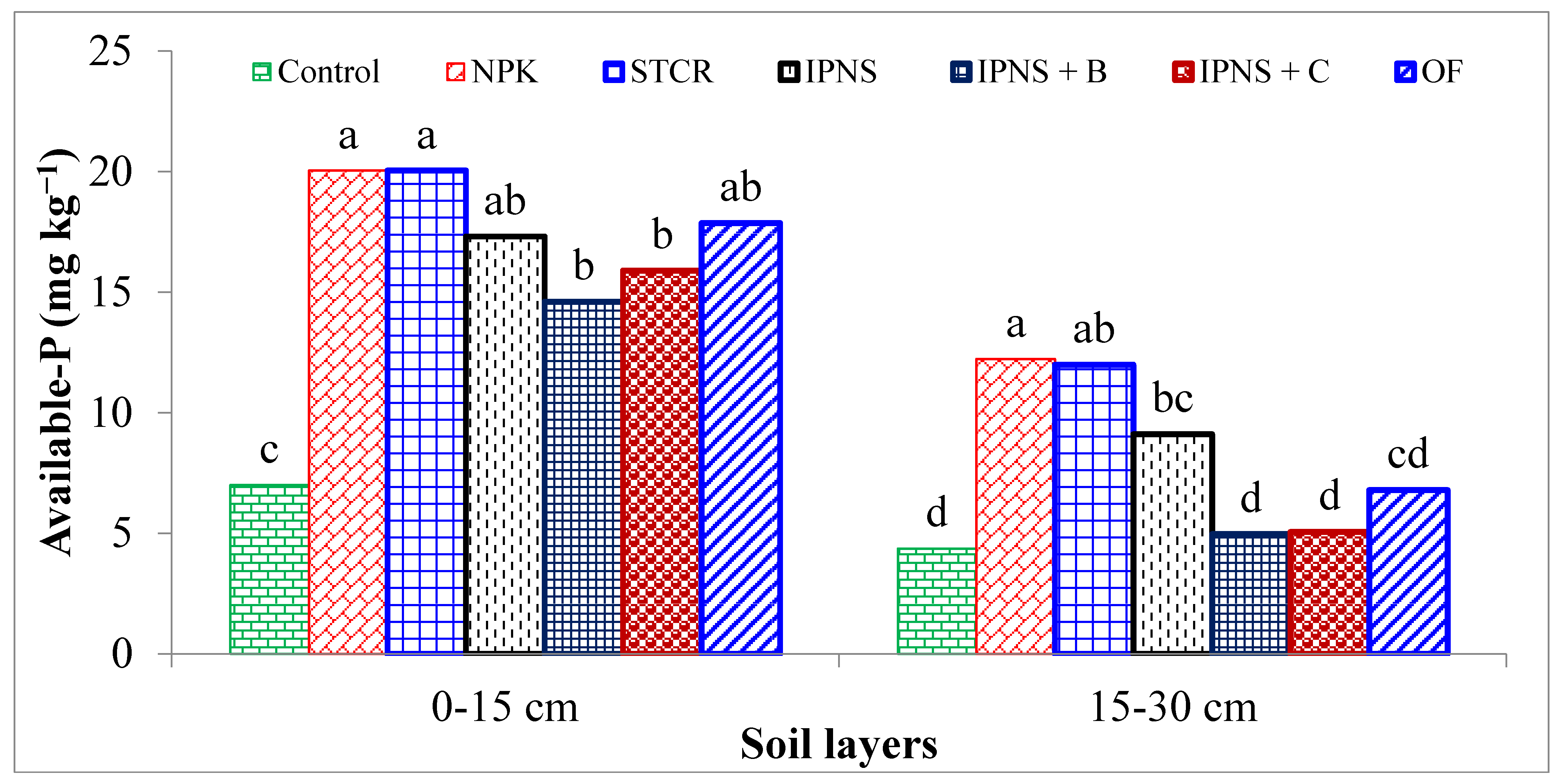
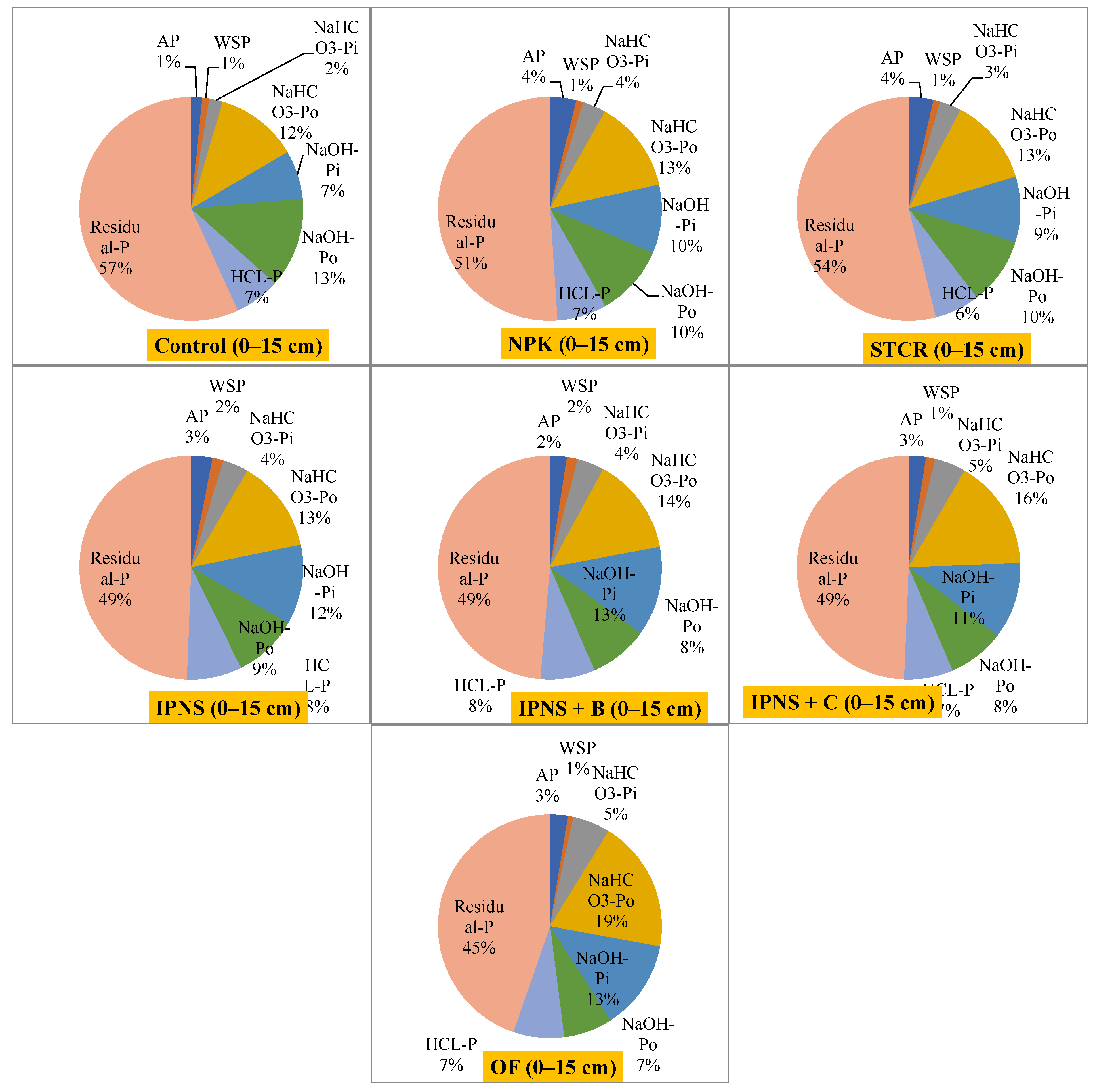
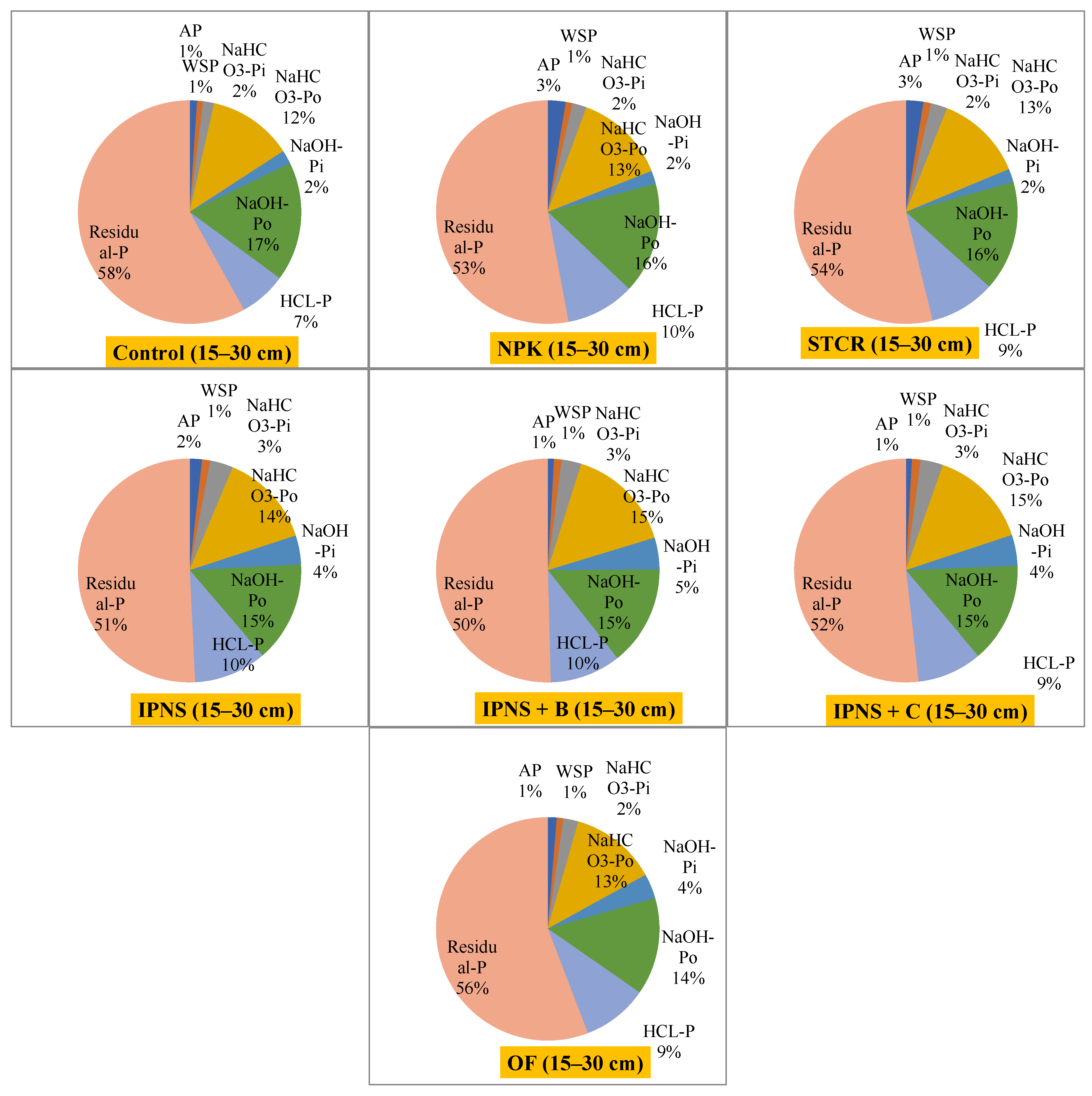
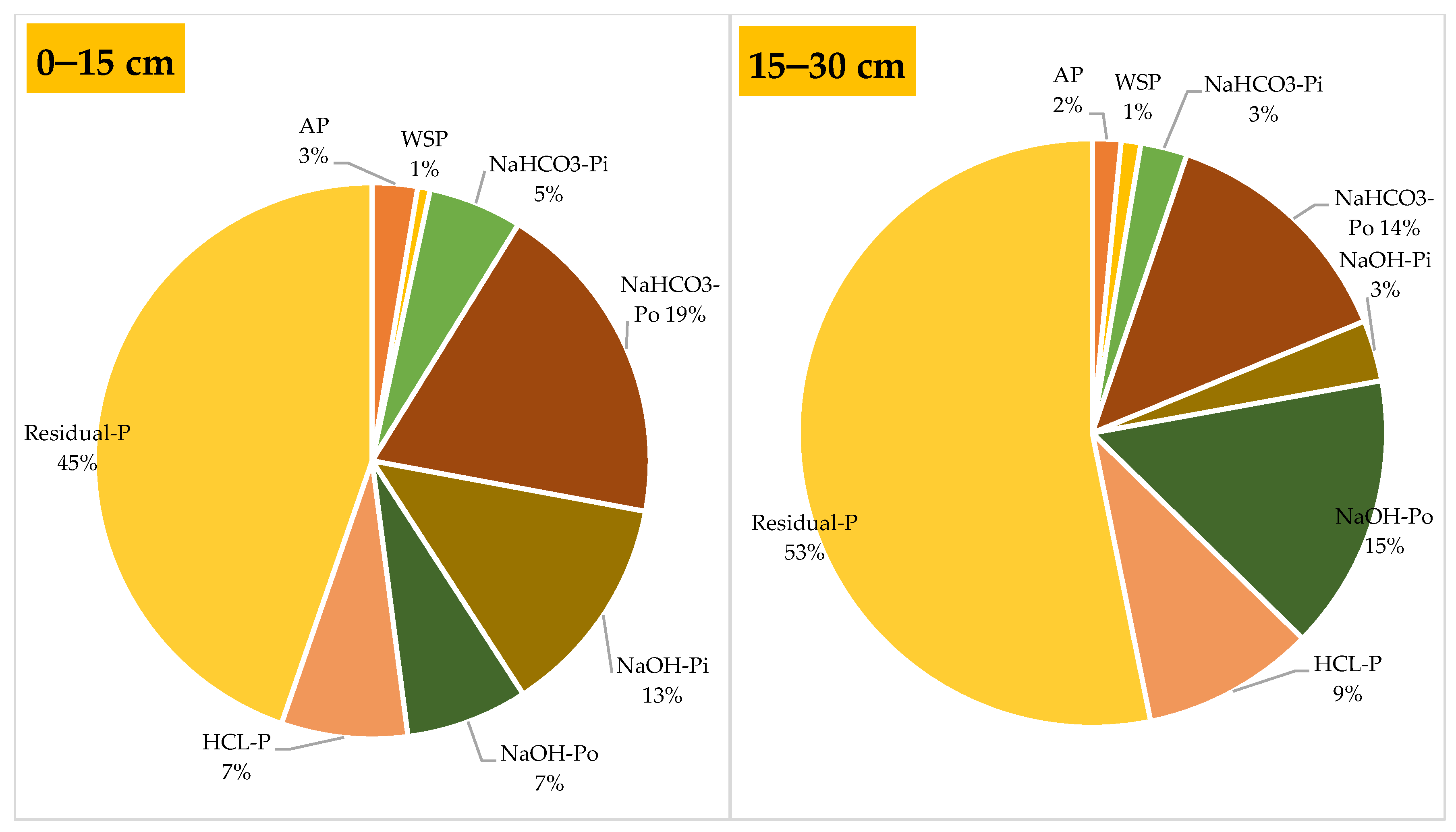
| Treatment | Treatment Details | ||
|---|---|---|---|
| Code | Kharif (Rice) | Rabi (Wheat) | |
| T1 | Control | No chemical fertilizer or organic manure | No chemical fertilizer or organic manure |
| T2 | NPK | Recommended N, P and K through fertilizers | Recommended N, P and K through fertilizers |
| T3 | STCR | Soil-test based fertilizer application | Soil-test based fertilizer application |
| T4 | IPNS | 75% of recommended N, P and K through fertilizers + 25% substitution of recommended N through FYM | Recommended N, P and K through fertilizers |
| T5 | IPNS + B | 75% of recommended N, P and K through fertilizers + 25% substitution of recommended N through FYM + every third wheat substituted with berseem | Recommended N, P and K through fertilizers |
| T6 | IPNS + C | 75% of recommended N, P and K through fertilizers + 25% substitution of recommended N through FYM + every third rice substituted with cowpea | Recommended N, P and K through fertilizers |
| T7 | OF | 100% of recommended N, P and K through organic manures (FYM) | 100% of recommended N, P and K through organic manures (FYM) |
| Treatments | WSP | NaHCO3-Pi | NaHCO3-Po | NaOH-Pi | NaOH-Po | HCl-P | Residual-P |
|---|---|---|---|---|---|---|---|
| mg P kg−1 | |||||||
| Control | 4.64 c | 8.71 e | 53.07 e | 31.13 e | 57.84 a | 29.28 e | 252.30 f |
| NPK | 5.43 bc | 17.73 d | 69.87 d | 52.22 d | 54.33 b | 37.47 d | 268.38 e |
| STCR | 5.57 b | 17.41 d | 70.60 d | 53.13 d | 54.18 b | 36.41 d | 301.01 b |
| IPNS | 8.67 a | 20.89 c | 74.56 cd | 64.58 c | 52.27 c | 44.49 c | 275.74 d |
| IPNS + B | 8.95 a | 23.43 c | 83.80 c | 76.76 b | 50.24 d | 46.74 b | 288.14 c |
| IPNS + C | 8.50 a | 28.49 b | 101.26 b | 70.40 c | 51.30 c | 44.69 c | 312.04 a |
| OF | 5.02 bc | 37.20 a | 130.16 a | 88.22 a | 48.33 e | 50.08 a | 304.69 b |
| Treatments | WSP | NaHCO3-Pi | NaHCO3-Po | NaOH-Pi | NaOH-Po | HCl-P | Residual-P |
|---|---|---|---|---|---|---|---|
| mg P kg−1 | |||||||
| Control | 3.45 d | 6.33 d | 48.83 c | 8.04 d | 68.70 d | 27.20 e | 231.16 f |
| NPK | 4.57 c | 9.50 c | 62.30 b | 8.95 d | 75.12 c | 46.44 d | 246.78 e |
| STCR | 5.19 c | 11.09 c | 59.67 bc | 9.13 d | 74.94 c | 44.67 d | 252.63 d |
| IPNS | 6.01 b | 16.94 ab | 68.81 b | 21.31 bc | 73.41 c | 53.19 b | 256.43 d |
| IPNS + B | 5.91 b | 15.51 b | 83.36 a | 24.76 ab | 78.05 b | 55.41 a | 272.52 c |
| IPNS + C | 7.44 a | 18.58 a | 83.76 a | 25.85 a | 83.68 a | 53.94 ab | 299.17 a |
| OF | 4.87 c | 11.23 c | 64.55 b | 18.40 c | 72.39 c | 48.95 c | 287.22 b |
| P-Fractions | WSP | NaHCO3-Pi | NaHCO3-Po | NaOH-Pi | NaOH-Po | HCl-P | Residual-P |
|---|---|---|---|---|---|---|---|
| Available-P | 0.096 NS | 0.443 NS | 0.352 NS | 0.462 NS | −0.462 NS | 0.441 NS | 0.530 NS |
| WSP | 1 | 0.241 NS | 0.107 NS | 0.442 NS | −0.442 NS | 0.542 NS | 0.300 NS |
| NaHCO3-Pi | 1 | 0.985 ** | 0.946 ** | −0.946 ** | 0.915 ** | 0.784 * | |
| NaHCO3-Pi | 1 | 0.892 ** | −0.892 ** | 0.844 * | 0.760 * | ||
| NaOH-Pi | 1 | −1.000 ** | 0.986 ** | 0.737 NS | |||
| NaOH-Po | 1 | −0.986 ** | −0.737 NS | ||||
| HCl-P | 1 | 0.674 NS |
Publisher’s Note: MDPI stays neutral with regard to jurisdictional claims in published maps and institutional affiliations. |
© 2022 by the authors. Licensee MDPI, Basel, Switzerland. This article is an open access article distributed under the terms and conditions of the Creative Commons Attribution (CC BY) license (https://creativecommons.org/licenses/by/4.0/).
Share and Cite
Meena, S.K.; Dwivedi, B.S.; Meena, M.C.; Datta, S.P.; Singh, V.K.; Mishra, R.P.; Chakraborty, D.; Dey, A.; Meena, V.S. Long-Term Nutrient Supply Options: Strategies to Improve Soil Phosphorus Availability in the Rice-Wheat System. Sustainability 2022, 14, 8629. https://doi.org/10.3390/su14148629
Meena SK, Dwivedi BS, Meena MC, Datta SP, Singh VK, Mishra RP, Chakraborty D, Dey A, Meena VS. Long-Term Nutrient Supply Options: Strategies to Improve Soil Phosphorus Availability in the Rice-Wheat System. Sustainability. 2022; 14(14):8629. https://doi.org/10.3390/su14148629
Chicago/Turabian StyleMeena, Sunita Kumari, Brahma Swaroop Dwivedi, Mahesh Chand Meena, Saba Prasad Datta, Vinod Kumar Singh, Rajendra Prasad Mishra, Debashish Chakraborty, Abir Dey, and Vijay Singh Meena. 2022. "Long-Term Nutrient Supply Options: Strategies to Improve Soil Phosphorus Availability in the Rice-Wheat System" Sustainability 14, no. 14: 8629. https://doi.org/10.3390/su14148629
APA StyleMeena, S. K., Dwivedi, B. S., Meena, M. C., Datta, S. P., Singh, V. K., Mishra, R. P., Chakraborty, D., Dey, A., & Meena, V. S. (2022). Long-Term Nutrient Supply Options: Strategies to Improve Soil Phosphorus Availability in the Rice-Wheat System. Sustainability, 14(14), 8629. https://doi.org/10.3390/su14148629







